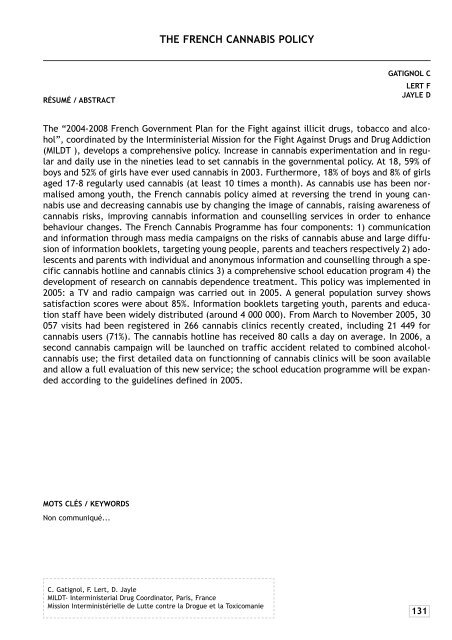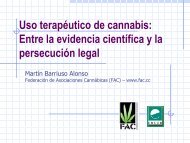Les Rencontres de Biarritz 2007 - THS 10
Les Rencontres de Biarritz 2007 - THS 10
Les Rencontres de Biarritz 2007 - THS 10
Create successful ePaper yourself
Turn your PDF publications into a flip-book with our unique Google optimized e-Paper software.
THE FRENCH CANNABIS POLICY<br />
RÉSUMÉ / ABSTRACT<br />
GATIGNOL C<br />
LERT F<br />
JAYLE D<br />
The “2004-2008 French Government Plan for the Fight against illicit drugs, tobacco and alcohol”,<br />
coordinated by the Interministerial Mission for the Fight Against Drugs and Drug Addiction<br />
(MILDT ), <strong>de</strong>velops a comprehensive policy. Increase in cannabis experimentation and in regular<br />
and daily use in the nineties lead to set cannabis in the governmental policy. At 18, 59% of<br />
boys and 52% of girls have ever used cannabis in 2003. Furthermore, 18% of boys and 8% of girls<br />
aged 17-8 regularly used cannabis (at least <strong>10</strong> times a month). As cannabis use has been normalised<br />
among youth, the French cannabis policy aimed at reversing the trend in young cannabis<br />
use and <strong>de</strong>creasing cannabis use by changing the image of cannabis, raising awareness of<br />
cannabis risks, improving cannabis information and counselling services in or<strong>de</strong>r to enhance<br />
behaviour changes. The French Cannabis Programme has four components: 1) communication<br />
and information through mass media campaigns on the risks of cannabis abuse and large diffusion<br />
of information booklets, targeting young people, parents and teachers respectively 2) adolescents<br />
and parents with individual and anonymous information and counselling through a specific<br />
cannabis hotline and cannabis clinics 3) a comprehensive school education program 4) the<br />
<strong>de</strong>velopment of research on cannabis <strong>de</strong>pen<strong>de</strong>nce treatment. This policy was implemented in<br />
2005: a TV and radio campaign was carried out in 2005. A general population survey shows<br />
satisfaction scores were about 85%. Information booklets targeting youth, parents and education<br />
staff have been wi<strong>de</strong>ly distributed (around 4 000 000). From March to November 2005, 30<br />
057 visits had been registered in 266 cannabis clinics recently created, including 21 449 for<br />
cannabis users (71%). The cannabis hotline has received 80 calls a day on average. In 2006, a<br />
second cannabis campaign will be launched on traffic acci<strong>de</strong>nt related to combined alcoholcannabis<br />
use; the first <strong>de</strong>tailed data on functionning of cannabis clinics will be soon available<br />
and allow a full evaluation of this new service; the school education programme will be expan<strong>de</strong>d<br />
according to the gui<strong>de</strong>lines <strong>de</strong>fined in 2005.<br />
MOTS CLÉS / KEYWORDS<br />
Non communiqué...<br />
C. Gatignol, F. Lert, D. Jayle<br />
MILDT- Interministerial Drug Coordinator, Paris, France<br />
Mission Interministérielle <strong>de</strong> Lutte contre la Drogue et la Toxicomanie<br />
131
















